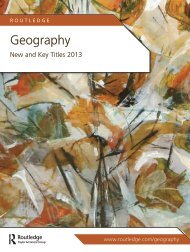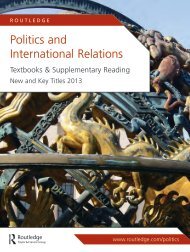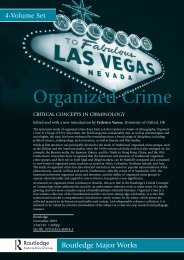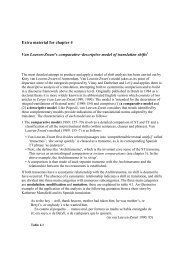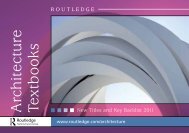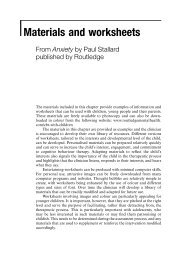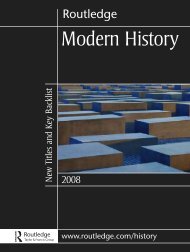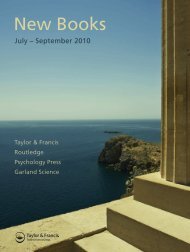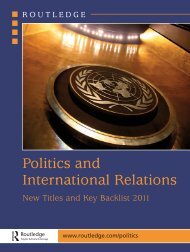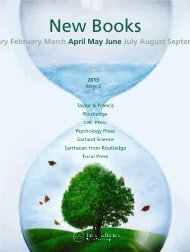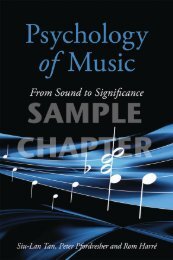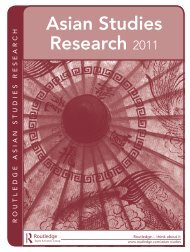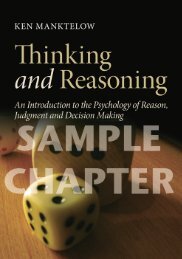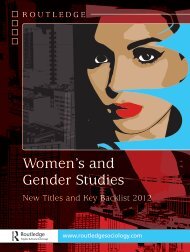Tim Burton: The Monster and the Crowd - A Post-Jungian Perspective
Tim Burton: The Monster and the Crowd - A Post-Jungian Perspective
Tim Burton: The Monster and the Crowd - A Post-Jungian Perspective
You also want an ePaper? Increase the reach of your titles
YUMPU automatically turns print PDFs into web optimized ePapers that Google loves.
22 Introduction<br />
competitive pool of valid <strong>and</strong> astute methodologies because, in my view, it<br />
perfectly suits <strong>the</strong> layout <strong>and</strong> meaning of <strong>Burton</strong>'s works, his creative<br />
habits, as well as his sublimation stimuli.<br />
<strong>Tim</strong> <strong>Burton</strong> is an essentially archetypal director in <strong>the</strong> sense that he<br />
works with basic mythological motifs. <strong>The</strong> principal <strong>the</strong>mes of his ®lms,<br />
especially <strong>the</strong> fa<strong>the</strong>r±son con¯ict, call for a psychoanalytic approach. As a<br />
practising psycho<strong>the</strong>rapist <strong>and</strong> `interpreter of dreams', Jung was more<br />
interested in <strong>the</strong> syntagmatic realisation of mythological structures than<br />
<strong>the</strong>ir history, formal properties or comparative possibilities. My choice of<br />
Jung over Freud <strong>and</strong> <strong>the</strong> post-Freudians is a matter of <strong>the</strong>ir different<br />
approaches to <strong>the</strong> treatment of symbols ± whe<strong>the</strong>r in dreams or in <strong>the</strong><br />
arts. Bearing in mind <strong>Burton</strong>'s anti-linguistic (or alinguistic) tendencies,<br />
Freudian, Lacanian <strong>and</strong> post-Freudian <strong>the</strong>ories are less applicable because<br />
<strong>the</strong>y place <strong>the</strong> linguistic above <strong>the</strong> visual. As Steven Walker observes, `By<br />
emphasising <strong>the</strong> image over <strong>the</strong> word, <strong>Jungian</strong> psychology differentiates<br />
itself radically from Freudian, Lacanian <strong>and</strong> o<strong>the</strong>r psychologies that stress<br />
<strong>the</strong> task of interpreting <strong>the</strong> language of <strong>the</strong> unconscious' (Walker, 2002: 3).<br />
Don Fredericksen draws attention to ano<strong>the</strong>r aspect of <strong>the</strong> same problem:<br />
Freud's `semiotic' (possibility of exact interpretation) <strong>and</strong> Jung's<br />
`symbolic' attitude (ampli®cation, or deferred interpretation) to <strong>the</strong> creative<br />
<strong>and</strong> dream-imagery. Jung does not see <strong>the</strong> unconscious as being linguistically<br />
structured, hence his rejection of semiotics in favour of ampli®cation.<br />
Jung writes in Psychological Types:<br />
<strong>The</strong> concept of symbol should in my view be strictly distinguished from<br />
that of sign. Symbolic <strong>and</strong> semiotic meanings are entirely different<br />
things ...Asymbol always presupposes that <strong>the</strong> chosen expression is<br />
<strong>the</strong> best possible description or formulation of a relatively unknown<br />
fact, which is none<strong>the</strong>less known to exist or is postulated as existing . . .<br />
Every view which interprets <strong>the</strong> symbolic expression as an analogue or<br />
an abbreviated designation for a known thing is semiotic. [. . .] <strong>The</strong><br />
symbol is alive only so long as it is pregnant with meaning. But once its<br />
meaning has been born out of it, once that expression is found that<br />
formulated <strong>the</strong> thing sought, expected, or divined even better than <strong>the</strong><br />
hi<strong>the</strong>rto accepted symbol, <strong>the</strong>n <strong>the</strong> symbol is dead, i.e., it possesses only<br />
an historical signi®cance ...Anexpression that st<strong>and</strong>s for a known<br />
thing remains a mere sign <strong>and</strong> not a symbol. It is, <strong>the</strong>refore, quite<br />
impossible to create a living symbol, i.e., one that is pregnant with<br />
meaning, from known associations.<br />
(Jung, 1971: CW6: paras. 814±818)<br />
Thus, a symbol is a relative <strong>and</strong> `immediate' thing, ra<strong>the</strong>r than a permanent,<br />
ready-made set of meanings. In a symbol, <strong>the</strong> relationship between <strong>the</strong><br />
http://www.jungarena.com/tim-burton-<strong>the</strong>-monster-<strong>and</strong>-<strong>the</strong>-crowd-9780415489713



